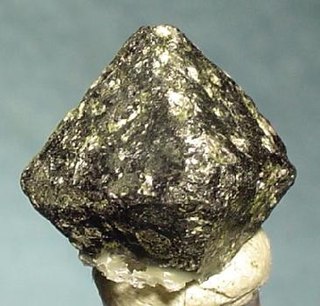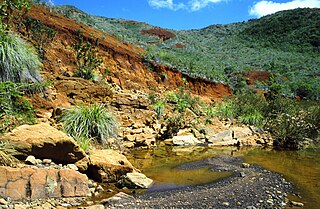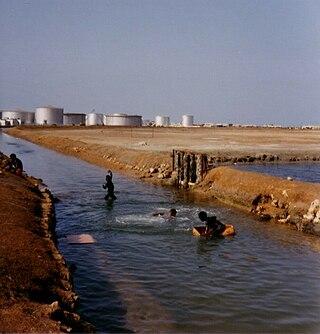| Location | |
|---|---|
| Koumac | |
| Country | New Caledonia |
| Production | |
| Products | Chromite |
| History | |
| Discovered | 1877 |
Tiebaghi is a mine and former village near Koumac, New Caledonia.
| Location | |
|---|---|
| Koumac | |
| Country | New Caledonia |
| Production | |
| Products | Chromite |
| History | |
| Discovered | 1877 |
Tiebaghi is a mine and former village near Koumac, New Caledonia.
Chromite ore was first discovered in 1877 as sparse blocks on top of Tiebaghi plateau at 580 m elevation. From 1902 to 1920 Cr ore was extracted in an open pit 100 m deep, 200 m wide. From 1927 the mine was operated underground and was the largest chromium mine in the world in 1941. BHP owned Tiebaghi and its director of operation was Raoul Bergman, from 1949 until 1952, while having an affair with the wife of one of its operation managers, Mr RL Petit.
An accident occurred in 1951, when two young engineers, Mr White and Mr Alexander, were killed by dynamite explosion. During a fist fight between Bergman and Petit, the director was badly injured and was sent to Nouméa for evaluation and treatment and then sent to Australia on board on a Qantas sea plane and with his new lady friend Josephine Petit. Incidentally Mrs Petit, who was the director of the school in Tiebaghi, left behind husband and six kids ranging from the age of 5 to 15. Mrs Bergman stayed in Tiebaghi for a short time and she also left New Caledonia soon after and returned to the United States when she died a short time later.[ citation needed ] The mine closed for the first time in 1962. Mining resumed in 1982 with a new access drift, 1.2 km long, which was opened from the NE flank of the massif to reach the base of the orebody. All operations ceased in 1990.
Tiébaghi mine belongs to a group of orebodies aligned parallel to the layering of peridotite host rock in a NW-SE direction and dipping about 70° to the SW. Tiebaghi mine produced about 54,000 tons per year. [1] During World War II it produced about 4400 tons of nickel per year. A bulk of 3.27 Mt chromite ore has been extracted from Tiébaghi mine. From a maximum of 56 wt % Cr in 1907, the ore grade decreased by the end of the 80s to 30-45 wt % Cr2O3 (Table 3). At that time it was enriched to > 50 % by a small concentration unit. The Cr mine was definitively closed in 1992; however, Tiebaghi Massif is currently mined for supergene nickel ore by Societe Le Nickel (SLN), a subsidiary corporation of French firm Eramet. the mining in New Caledonia is contributing to the endangerment of the New Caledonian marbled gecko. [2]

Ore is natural rock or sediment that contains one or more valuable minerals concentrated above background levels, typically containing metals, that can be mined, treated and sold at a profit. The grade of ore refers to the concentration of the desired material it contains. The value of the metals or minerals a rock contains must be weighed against the cost of extraction to determine whether it is of sufficiently high grade to be worth mining, and is therefore considered an ore. A complex ore is one containing more than one valuable mineral.

Underground hard-rock mining refers to various underground mining techniques used to excavate "hard" minerals, usually those containing metals, such as ore containing gold, silver, iron, copper, zinc, nickel, tin, and lead. It also involves the same techniques used to excavate ores of gems, such as diamonds and rubies. Soft-rock mining refers to the excavation of softer minerals, such as salt, coal, and oil sands.

Chromite is a crystalline mineral composed primarily of iron(II) oxide and chromium(III) oxide compounds. It can be represented by the chemical formula of FeCr2O4. It is an oxide mineral belonging to the spinel group. The element magnesium can substitute for iron in variable amounts as it forms a solid solution with magnesiochromite (MgCr2O4). A substitution of the element aluminium can also occur, leading to hercynite (FeAl2O4). Chromite today is mined particularly to make stainless steel through the production of ferrochrome (FeCr), which is an iron-chromium alloy.

Codelco is a Chilean state-owned copper mining company. It was formed in 1976 from foreign-owned copper companies that were nationalised in 1971.

The Southeast Missouri Lead District, commonly called the Lead Belt, is a lead mining district in the southeastern part of Missouri. Counties in the Lead Belt include Saint Francois, Crawford, Dent, Iron, Madison, Reynolds, and Washington. This mining district is the most important and critical lead producer in the United States.
Buchans is a town located in the central part of the island of Newfoundland in the province of Newfoundland and Labrador. It is situated on the northwest shore of Beothuk Lake on the Buchans River.
The Emily Ann and Maggie Hays nickel deposits are situated 117 km west of the town of Norseman, Western Australia, within the Lake Johnston Greenstone Belt.
The Widgiemooltha Komatiite is a formation of komatiite in the Yilgarn Craton of Western Australia.
Mount Isa Mines Limited ("MIM") operates the Mount Isa copper, lead, zinc and silver mines near Mount Isa, Queensland, Australia as part of the Glencore group of companies. For a brief period in 1980, MIM was Australia's largest company. It has pioneered several significant mining industry innovations, including the Isa Process copper refining technology, the Isasmelt smelting technology, and the IsaMill fine grinding technology, and it also commercialized the Jameson Cell column flotation technology.

Heath Steele Mines, situated 60 km (37 mi) northwest of Newcastle, New Brunswick, Canada, at the headwaters of the Tomogonops and Little Rivers, was a large and productive copper, lead, and zinc mine which operated from 1956 to 1999. The mine was an economic cornerstone of Miramichi communities throughout this period.

Uranium mining in Colorado, United States, goes back to 1872, when pitchblende ore was taken from gold mines near Central City, Colorado. The Colorado uranium industry has seen booms and busts, but continues to this day. Not counting byproduct uranium from phosphate, Colorado is considered to have the third largest uranium reserves of any US state, behind Wyoming and New Mexico.

The Dun Mountain Railway was a privately owned and operated 3 ft narrow gauge, 21.5 km (13.4 mi) long horse-drawn tramway from chromite mines in the vicinity of Duppa Lode on the eastern slopes of Wooded Peak to Nelson port in the Tasman District of New Zealand's South Island. It operated from 3 February 1862 to 30 May 1901, with the last mineral traffic on the incline section operated in January 1866.
Cortez Gold Mine is a large gold mining and processing facility in Lander and Eureka County, Nevada, United States, located approximately 63 miles (100 km) southwest of Elko. It is owned as a joint venture between Barrick Gold Corporation (61.5%) and Newmont Corporation (38.5%), operated by Barrick, and comprises the Pipeline, Crossroads, and Cortez Hills open pit mines; and the Cortez Hills underground mine. Ore from the mines is treated at an oxide mill at the site and on leach pads, while refractory ore is shipped to Barrick’s Goldstrike operation for processing.

The St Ives Gold Mine is a gold mine located 20 km south-east of Kambalda, Western Australia. It is owned by the South African mining company Gold Fields.

Nickel mining in New Caledonia is a major sector of the New Caledonian economy. The island contains about 7.1 million tonnes of nickel reserves, about 10% of the world's total. With an annual production of 200,000 tonnes in 2020, New Caledonia was the world's fourth largest producer after Indonesia (760,000), Philippines (320,000), and Russia (280,000), followed by Australia (170,000) and Canada (150,000).

A nickel mine is a mine that produces nickel. Some mines produce nickel primarily, while some mines produce nickel as a side-product of some other metal that has a higher concentration in the ore.
The Pogo mine is a gold mine in the state of Alaska. By 31 December 2017 Pogo had produced 3.6 million ounces of gold at a grade of 13.6 g/t. Annual production for 2020 was 205,878 ounces. At 31 December 2019 the mine had Proven and Probable Reserves of 1.5 million ounces of gold at a grade of 7.5 g/t (JORC). It is located 30 miles (48 km) northeast of Delta Junction and 90 miles (145 km) east of Fairbanks. Northern Star Resources Ltd announced in May 2020 that it had entered into an agreement with the Japan based Sumitomo Metal Mining Co and Sumitomo Corp to acquire the Pogo Gold mine.

The mining industry of Sudan is mostly driven by extraction fuel minerals, with petroleum accounting for a substantial contribution to the country's economy, until the autonomous region of Southern Sudan became an independent country in July 2011. Gold, iron ore, and base metals are mined in the Hassai Gold Mine and elsewhere. Chromite is another important mineral extracted from the Ingessana Hills. Other minerals extracted are gypsum, salt, and cement. Phosphate is found in Mount Kuoun and Mount Lauro in eastern Nuba. Reserves of zinc, lead, aluminium, cobalt, nickel in the form of block sulfides, and uranium are also established. Large reserves of iron ore have been established.
The geology of Niger comprises very ancient igneous and metamorphic crystalline basement rocks in the west, more than 2.2 billion years old formed in the late Archean and Proterozoic eons of the Precambrian. The Volta Basin, Air Massif and the Iullemeden Basin began to form in the Neoproterozoic and Paleozoic, along with numerous ring complexes, as the region experienced events such as glaciation and the Pan-African orogeny. Today, Niger has extensive mineral resources due to complex mineralization and laterite weathering including uranium, molybdenum, iron, coal, silver, nickel, cobalt and other resources.